|
Related FAQs: Mussids, Mussids
2, Mussid Identification,
Mussid Behavior, Mussid Compatibility, Mussid Selection, Mussid Disease, Mussid Systems, Mussid Feeding, Mussid Reproduction, Stony/True Coral, Coral System Set-Up, Coral System Lighting, Stony Coral Identification, Stony Coral Selection, Coral Placement, Foods/Feeding/Nutrition, Disease/Health, Propagation, Growing Reef Corals, Stony Coral Behavior,
Related Articles: Large Polyp Stony
Corals, Stony or True Corals,
Order Scleractinia, Dyed Corals,
/The Best Livestock For Your Reef Aquarium:
Brain, Meat, Pineapple
Corals, Family Mussidae, Pt. 7
To:
Part 1, Part 2, Part
3, Part 4,
Part 5, Part 6,
Part 8,
|
|
Genus Scolymia Haime 1852. Singular, circular polyps.
Indistinct walls beneath their septa-costae. These are difficult
species to discern one from the other. The three occurring in the
tropical West Atlantic may be told apart by the shape of their septal
"teeth". Tropical W. Atlantic, Western Pacific and Indian Oceans
(see the note below re moving Indo-Pacific Scolymia to Acanthophyllia).
|
Yo Bob
10/27/13
Mussid ID corr.s, Indo-Pacific Scolymia are now Acanthophyllia
Hi Bob,
<Hey Jules... now am humming the Beatles tune... A to middle C>
It was nice seeing you last weekend, as always.
<Ahh, a very nice time indeed>
I was just browsing Google looking at some coral photos to help
illustrate the answer to a taxonomic question someone sent me, and I
happened to notice that you have a very special photo on your site-- I
know, you probably are thinking that all of your photos are special.
They are, but this one is particularly so. I have attached it here.
<Will look for... oh, I see you explain below>
You use to illustrate Scolymia, hence the name you gave the photo, but
it is not Scolymia. It is Acanthophyllia deshayesiana. It is a common,
high-value import from Indonesia, usually imported as Scolymia,
sometimes as Cynarina, but now legally only as Acanthophyllia. Long
story. The are many many photographs of this coral in aquariums since it
is a very popular aquarium coral. There are to the best of my knowledge
no published photographs of it taken in the wild. Hence my interest in
your photo.
<Ahh, thank you>
You listed Raja Ampat as the locality. Do you remember the depth and any
other details?
<Aye yi yi... I barely remember what I made for bfast this AM. Many
years... decades back, I showed some discipline in labeling just
finished rolls of film with such notes... >
Even the "Cynarina lacrymalis" featured just above the
Acanthophyllia, also photographed at Raja Ampat, is likely a special
photo. I believe it shows Indophyllia macassarensis, which is
sometimes not easy to distinguish from Cynarina lacrymalis, and
sometimes not easy to distinguish from Acanthophyllia deshayesiana. If
you look at my book Corals A Quick Reference Guide you will see that I
grouped these three species into the genus Cynarina, which is what I
suspect will ultimately happen on the taxonomic front, though it may
take many years.
<Am very inclined to beg you to look through my (many, Way too many)
totally unidentified Cnid. pix, let alone my likely mis-id'ds>
With your permission I would like to forward a copy of this photo to
Charlie Veron. He has recently recognized the validity of this coral
(after many years of me beating him over the head about it because he
refused to separate it from Cynarina lacrymalis). He has lots of good
AQUARIUM photos of it to illustrate his online version of Corals of the
World, but he has no underwater photos from the natural setting. I am
sure he would love to feature your photo.
Best Regards, Julian
<Ah, certainly... I will take a quick look on my HD and attach the
original here for all's use; actually three others labeled in the same
series. Cheers, BobF>
|
%20MD.JPG) |
| Scolymia cubensis (Milne Edwards and Haime
1849). Septa in 2,3 orders as spikes, pick-shapes; and convex or flat (rarely
concave) centers. Fleshy; with lines radiating from center outward. Found in the
Caribbean and off of Brazil. Bahamas and Bonaire
pix. |
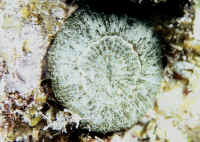 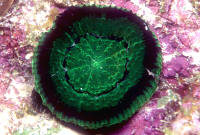
|
Bigger PIX:
The images in this table are linked
to large (desktop size) copies. Click on "framed" images
to go to the larger size. |
%20MD.jpg)
%20MD.jpg)
%20MD.jpg)
%20MD.JPG)
%20MD.JPG) |
| Scolymia lacera, Atlantic Mushroom Coral.
Tropical West Atlantic. To six inches in diameter, most a couple of
inches. Fleshy w/ definite concave centers. Have prominent triangular septal teeth ridges and a "warty
appearance" compared w/ other TWA members of the genus. Cozumel
image by Di.F. |
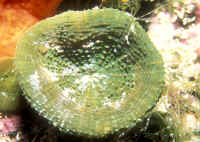 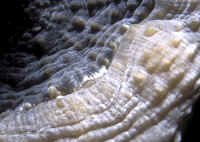
|
| Scolymia vitiensis Bruggenmann 1877. Septa
slope up from the columellae, costae slope down to the perimeter.
Look like Fungiids with a depressed center otherwise. One in Fiji,
another in an aquarium. Below, two in Nuka Hiva, Marquesas,
Polynesia. |
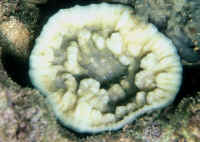 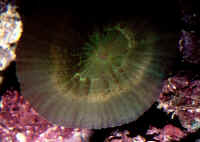
|
Bigger PIX:
The images in this table are linked to large (desktop size) copies.
Click on "framed" images to go to the larger size. |
|
%20MD.JPG)
|
| Scolymia wellsi, Solitary Disk Coral.
Radiating, raised lines on polyp. Occur in greens, grays, browns.
Has rough, irregular cylindrical, thin septal teeth; concave (rarely convex)
centers. Cozumel
pic. |
%20MDE.JPG)
|
Bigger PIX:
The images in this table are linked
to large (desktop size) copies. Click on "framed" images
to go to the larger size. |
%20MD.jpg)
%20MD.JPG) |
To:
Part 1, Part 2, Part
3, Part 4,
Part 5, Part 6,
Part 8,
|
|

